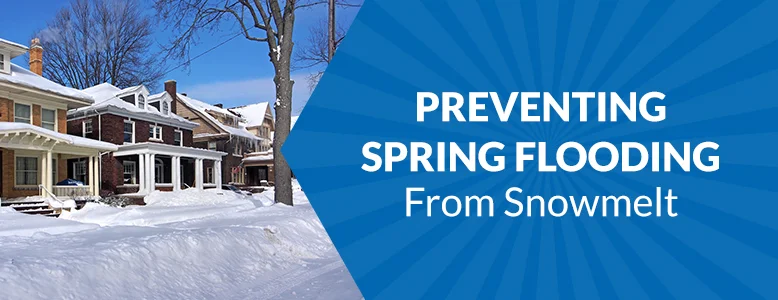
Most people welcome spring with open arms. The weather is warming, days are lengthening and signs of new growth are everywhere. Leaves appear, birds return and flowers bring their showy blooms. For many, spring is their happiest season of the year. Unfortunately, that’s not the case for some homeowners. Spring is the time heavy snow dissipates and leaves copious amounts of snowmelt water. These folks live in seasonal fear because they know rapid snowmelt creates a dangerous risk for flooded basements.
Basement flooding is a serious and expensive problem. According to the FEMA National Flood Insurance Program, flood damage is the No. 1 natural disaster in America. Flooded basements and homes amount to more than $3 billion in paid-out insurance claims annually. Most of this comes from sudden spring snowmelt flooding.

Sadly, a great deal of snowmelt flood damage is preventable. Homeowners who take the right preventive measures are far less likely to incur flood damage than those who neglect simple maintenance tasks. These folks fail to carry out proper snow management techniques, which involve a combination of diverting snowmelt water away from the home and being able to effectively pump out water that manages to enter.
How Does Snowmelt Cause Flooding?
Snowmelt definition refers to water runoff resulting from melting snow. It is part of nature’s water cycle. All cold climates in the United States experience some degree of fallen snow in the winter. Most snow accumulates at higher elevations and accounts for what is called the snowpack.
Snowpacks are vital for most state and local water systems. When snowpacks melt at a normal rate, they release water in a controlled manner. Water runoff follows natural courses and eventually gets drawn out to the sea by gravity. Along the way, a great deal of snowmelt water gets absorbed into the ground and forms natural underground aquifers.
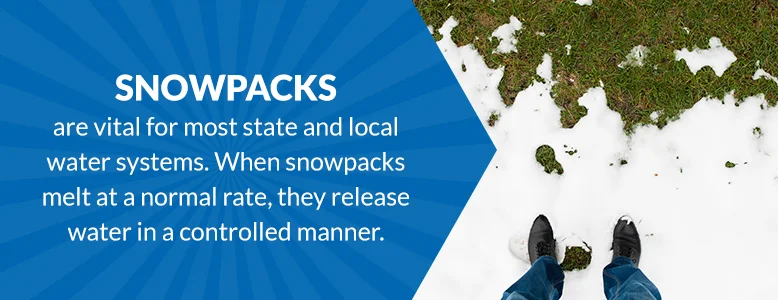
In normal years, a certain rate of snowmelt water is expected and allowed for. High winter precipitation regions like the Northeastern states have regular water management plans and systems in place. However, they cannot always be prepared for the perfect storm when high volumes of snow rapidly melt from seasonal extremes like sudden warm weather and heavy rains.
Factors Affecting Snowmelt Flooding
Snowmelt causes flooding when excessive meltwater cannot be controlled. This occurrence is not always predictable and can happen in a flash. Snowmelt flooding occurs when any of the six factors become imbalanced and affect normal spring thawing. They are:
- Heavy winter snow cover — Environmental engineers have a principle called the hundred-year rule. Once in a certain period, weather extremes will happen, such as an unusually large snowfall. This event is region-dependent and results from massive amounts of snow accumulating. It becomes dangerous when temperatures suddenly warm and snowmelt rapidly happens.
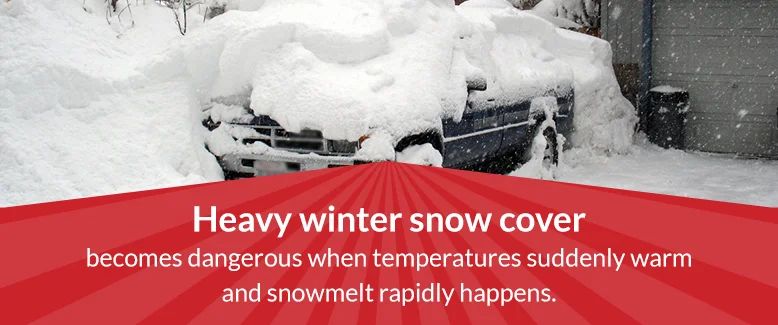
- Sudden temperature increase — As long as spring temperatures gradually increase, snowmelt happens slowly. Streams, rivers, and lakes can manage this without getting overwhelmed. Civic infrastructure, like controlled dams and storm drain systems, also safely handles spring runoff. Homeowners can manage expected snowmelt around their property by using runoff grades and backup pump systems. These systems all work well until temperatures suddenly increase and rapid snowmelt overwhelms them.
- High soil moisture conditions before snowmelt — Areas that received heavy fall precipitation will have ground soil already saturated before winter’s snow arrives. These regions can't take on any additional surface water and let it percolate through to the subterranean aquifer. Evaporation can’t happen due to decreasing temperatures as the season progresses. Natural runoff is then stopped by the ground eventually freezing.
- Ground frost and frozen soil — Once the ground becomes a block of ice, it is impossible for water to enter. Ground frost also seals the surface, and conditions stay this way until spring weather warms the soil. That takes time and greatly relies on snowmelt water to gradually warm the ground so it can absorb surface water at a controlled rate. Excessive water on the frozen ground has no option but to let gravity pull it downhill along the surface.
- Heavy spring rains — Heavy spring rains present two serious flooding threats. One is quickly melting the snowpack, causing it to release uncontrollable snowmelt water. Secondly, heavy rains add considerably more water volume to the area. When spring rain is above natural levels and the ground is still frozen, this triggers the perfect storm of having far more water than can be controlled. Then, flooding is inevitable.
- Ice and debris jams — Adding to the perfect flood storm are ice and debris jams. Suddenly, increased snowmelt sends massive water volume through streams and rivers, causing them to pile up breaking ice and dislodging vegetation. These temporary blockages hold back huge water reservoirs that break without warning. Instant flooding happens when ice and debris dams snap. The previous five flooding factors compound that condition.
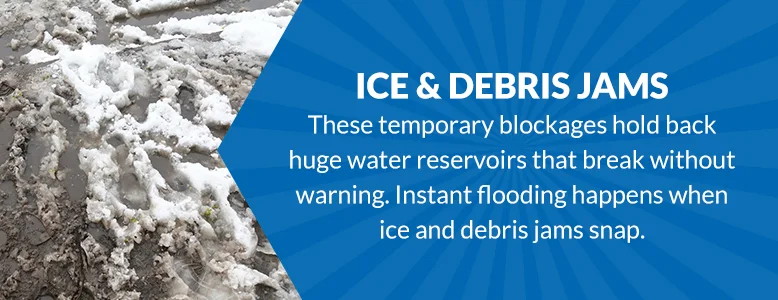
The highest-risk geographical areas for spring flooding are low-lying regions with high snowpacks above them. The hilly areas around north-central greater Syracuse, N.Y., are a prime target for uncontrolled snowmelt. That means a serious risk of flooded basements in the spring.
Common Issues and Solutions for Snowmelt Flooding
Common issues in homes due to snowmelt flooding include water damage to structural members and stored contents. Standing flood water also quickly leads to mold growth. Mold colonies present a serious health risk, especially to the young and elderly with weakened immune systems. The cumulative financial and health damage from snowmelt floods is crippling.
Finding basement flooding solutions and knowing how to stop basement flooding is something every homeowner needs. That’s particularly urgent in high-risk locations where homes are near watercourses and downstream from water reservoirs. Basement flooding management should also be a top priority for owners located on clay-based ground with poor drainage capacity.
Homes in high-risk regions can be in both municipal and rural locations. Most cities have effective storm and sanitary sewer systems, but even the best-equipped places can’t manage severe and unexpected flood conditions. Rural property homeowners are left to fend for themselves in managing snowmelt. They need special vigilance to be aware of common issues and find solutions for snowmelt flooding.
Snowmelt management solutions start with having a plan to deal with floodwater before it enters the basement. The best plans include using gravity to slope water away from the foundation. This task involves lot grading and providing artificial drain pipes around the foundation perimeter. The next line of defense is waterproofing the foundation to act as a sealant or exterior dam.
However, despite all practical solutions for exterior management, water is an immense force. It can find its way inside through the smallest foundation cracks or build to the point that it overflows thresholds. Then, sure as gravity, water will seep to the lowest point — the basement floor. Proper plumbing can save the day in these situations.
One of the biggest flood prevention tactics homeowners need is a professional inspection of their basement plumbing systems. Even if floodwater comes into their basement, properly working drains and sump pumps will likely control floodwater until nature’s cycle improves. Something as simple as a blocked drain or deficient sump pump can result in thousands of dollars in damage. For snowmelt flood threats, a little bit of preventive maintenance goes a long way.
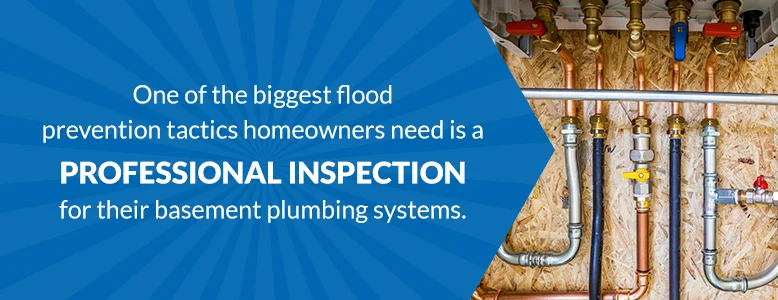
Tips to Prevent and Control Snowmelt Flooding
As the old saying goes, an ounce of prevention is worth a pound of cure. It's true, especially for managing snowmelt flood threats. The primary task in managing snowmelt runoff is removing as much packed snow as possible from around the home. Second to that is having an effective drainage system for relieving water volume. Consider these facts about the ratio of packed snow to liquid water:
- One cubic foot of packed snow will melt into two to three gallons of water.
- A 1,000-square-foot roof covered in one foot of compressed snow will melt into 2,500 gallons of water.
- A 40-foot-diameter, 10-foot-high snow pile will melt into 5,000 gallons of water.
While only so much can be done to fend off rushing water from overflowing rivers sent by melting snow packs, homeowners can take proactive steps to manage snow buildup around their property. There are plenty of ways to manage water that finally makes its way into a basement, as well. Here are some tips to prevent and control snowmelt flooding:
- Remove as much standing snow as possible — Flood management depends on keeping snowmelt away from the foundation perimeter. If possible, shovel off roof snow buildup to prevent melting and overloading the gutters, downpipes, and perimeter drain systems. It’s not enough to leave shoveled snow on the ground. Removing as much as possible will prevent melting pools. Consider using a machine to scoop up and haul off bulk snow piles.
- Manage snow piles strategically — Make sure not to shovel snow toward the foundation or crease piles close by. That is just asking for trouble. Strategically pile snow downhill from the house. Preferably, snow piles should be close to the natural runoff from the property. The same goes for blowing snow. Snow must be blown away from the buildings and not toward some location that will trap the eventual melt.
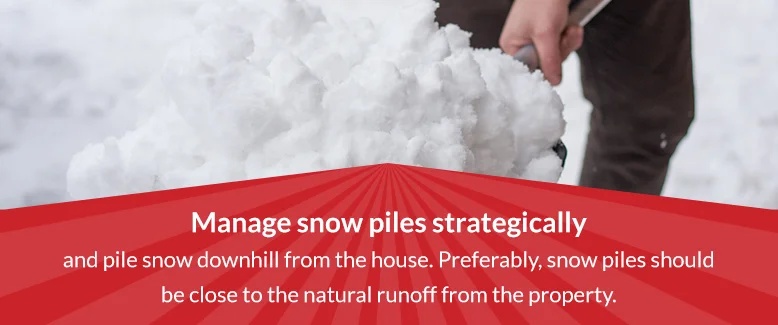
- Remove blocks that trap snowmelt runoff — Ensure melting snow has an easy escape route. Running water always follows the path of least resistance. Give snowmelt a channel to run through and make sure nothing blocks the path. Conversely, consider making dams or blockages upstream. Stop higher snowmelt and give it a diversionary route.
- Grade the foundation perimeter surface — Lot grading should always slope away from the foundation, not toward it. This is one of the biggest reasons owners have trouble with snowmelt water. For the most part, gravity is the biggest influence on moving surface and subsurface water. For gravity to do its part, it needs a slope. Plumbing codes call for non-pressurized water pipes to carry a slope of no less than a quarter-inch per foot. Proper and effective lot grades should have a more aggressive slope, such as one inch over one foot running away from the building.
- Ensure gutters, downspouts, and drains are unobstructed — Unblocking gutters, downspouts, and drains is an autumn task and part of normal homeowner preventive maintenance. Gutters that contain dead leaves and shingle grit can’t handle roof water efficiently. Neither can obstruct downspouts. Even if gutters and downspouts run free, blocked perimeter drains ruin the whole process. Professional drain cleaning is well worth the investment.
- Seal your foundation — Sealing a foundation is a mandatory step in preventing water ingress. It is best to do this step during the building construction phase when the backfill is open and the foundation is new. Digging up an existing foundation to waterproof it is difficult and expensive. Consider using a synthetic drainage plane along the foundation exterior, as well as using free-draining backfill. The idea is to relieve hydrostatic pressure created by standing groundwater that then drains away by the weeping tile.
- Use sandbags — A well-designed and -built foundation waterproofing and drainage system will hold back water for a long time. It is similar to a properly constructed dam containing a lake. However, that defense breaks down once water breaches its top. In a home, that is usually where the wood frame plates meet the concrete foundation top. Door thresholds and basement window wells are especially vulnerable. Having an emergency supply of sand and sandbags can buy vital time to stop water flow from entering the basement.
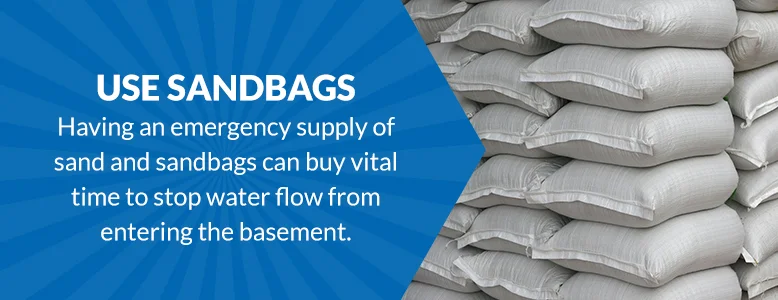
- Have an operable sump pump — When all control/prevention measures fail and water enters the basement, the best remedy is an operable sump pump. The key word is “operable,” as a faulty sump pump is next to useless. Much of this depends on sump pump installation and sump pump maintenance. This is where licensed, professional plumbers are flood-threat assets.
How to Stop Your Basement From Flooding in the Spring
The best advice any homeowner can get about how to stop their basement from flooding in the spring is, “Be prepared.” Proper snow pile management is the front-line defense. If snow is not there, there is not going to be an immediate problem. This holds true unless snowmelt water arrives from an uphill source.
Stopping water from entering a basement is all about removing the immediate threat, and then being prepared to manage or control excess water from off-property sources by diverting, blocking, and draining away surface water. This will likely be a short time while peak runoff occurs.
High groundwater tables are just as threatening as excessive surface snowmelt. Groundwater takes a lot longer to dissipate than surface water. It moves slowly and requires percolation or mechanical drainage. Groundwater needs somewhere to go and is not receptive to evaporation like surface melt is.
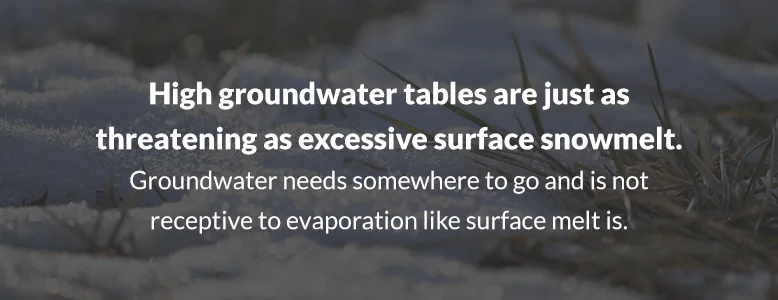
If water does enter the basement, it is usually manageable without long-term damage. However, standing water left for any lengthy period quickly turns stagnant. Standing water leads to rotting contents, damaged wood structures, and, in all likelihood, serious mold damage. A mess like this can cost thousands of dollars to remediate.
Basements should be designed for an inevitable flood. That can come from exterior snowmelt that is not controlled. It can also happen from interior water sources, like a burst hot water tank, a stuck toilet, an overflowing tub, or a ruptured pressure line.
Stopping these unexpected flood conditions is easy: Turn off the water source until the problem gets fixed. That is not so simple when dealing with water entering a basement from flooding snowmelt. This is when homeowners rely on their basement sump pump.
What Is a Sump Pump?
When hearing the term “sump pump,” many homeowners might wonder, "What does a sump pump do?" or, "How does a sump pump work?" The word “pump” is common enough, but “sump” may be unfamiliar. A pump refers to any mechanical device that moves liquids. For basements, that chore goes to pumping unwanted water from the floor, and the lowest point is called the sump.
Sumps are small wells intentionally built into the basement floor. They serve two purposes. One is to catch water ingress like snowmelt flooding or uncontrolled interior spills. The second purpose is to relieve hydrostatic pressure created by existing groundwater tables that enter a basement from below the concrete floor.
Sump holes are also called pits or crocks. These strategically located wells are usually about 18 inches in diameter and about two feet deep. Sump linings are normally PVC plastic or galvanized metal, and the bottoms contain free-draining crushed rock, allowing for a natural water collection point.
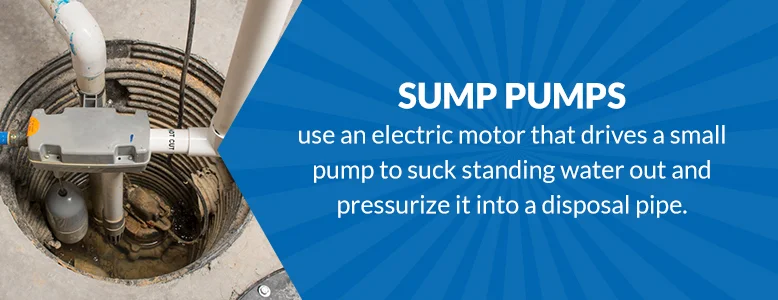
Sump pumps are electric devices that use household current. The electric motor drives a small pump to suck standing water out and pressurize it into a disposal pipe. That can lead to the drain on a rural property using a septic system. The pressure outlet can also tie into a municipal stormwater catchment. Sump pump water must never enter a sanitary sewer or septic tank. In some jurisdictions, it is illegal.
There are many sump pump makes and models available across the country. Generally, sump pumps have two power capacities: 1/3 horsepower, and 1/2 horsepower. Pump designs allow them to plug into a home’s wiring system, but they should be on a dedicated circuit with a ground fault circuit interrupter for safety.
Many sump pumps have an audible alarm warning system when the pump fails. Some also have a battery backup in case the power grid goes out. This applies to both types of sump pumps. Sump pump variations include:
- Pedestal sump pumps that stand upright with their electric motors remaining dry
- Submersible sump pumps that are one piece and drop directly into the wet sump pit
Regardless of a sump pump’s design, all activate through a float switch. A float ball attaches to the pump motor, allowing it to turn on as the water level rises. Sump pumps continue running as long as the float remains buoyed by standing water. Something else all sump pumps have in common is they need periodic maintenance.
Sump Pump Maintenance

Quality sump pumps are dependable with proper maintenance. A proper sump pump maintenance program includes servicing on a quarterly and annual basis. Homeowners who are not mechanically inclined should leave this to a licensed plumber who can catch potential problems before they end up in a flooded basement.
Safety is paramount when servicing a sump pump. Rubber boots are mandatory, as is shutting off the power prior to handling a sump pump. Here are some maintenance tasks to do quarterly.
- Lift the pump from the pit and check the screen. Sump pumps do not have filters. However, they do have mesh screens to protect the pump impeller from grit. Foreign matter can be removed by hand, washed under a hose, or blown with compressed air.
- Check the power supply and cord. Ensure the breaker is set and there is no notable cord damage, which can lead to a serious short or a fire.
- Replace the pump, plug it in, and pour a bucket of water into the pit. The float should automatically rise and activate the pump, which will stop once the float drops down. If this is not working, call a plumber who is trained to repair sump pumps.
More sump pump maintenance happens annually. Fall is the best time, as groundwater tends to be lower. It also allows plenty of time to fix problems before the spring snowmelt starts. These are recommended annual sump pump maintenance tasks:
- Remove, clean, and test the sump pump.
- While the pump is out, clean the pit and remove any sludge or debris that could block the pump.
- Run the pump for an extended period and do several off/on tests.
- Call a plumber for a second opinion or for an estimate on the remaining sump pump life.
- If there is any indication of trouble, have the plumber repair or replace the sump pump or any part of the drainage system.
Call Mr. Rooter Plumbing of Greater Syracuse for Sump Pump Installation, Maintenance, and Repair
Mr. Rooter Plumbing of Greater Syracuse is a franchised member of the nationwide Mr. Rooter Plumbing chain. Our licensed plumbers take pride in delivering exceptional customer service. Prompt attention to an emergency is paramount in Mr. Rooter's culture. That includes immediately responding to any snowmelt and sump pump problems that could cause a flooded basement.
Respect, integrity, and customer focus are core values at Mr. Rooter, including the two upstate New York locations in Syracuse and Oneida. We’re available on a 24/7 emergency standby and offer regular services, including fixture replacement, repair, and clearing of blockages. Sump pump maintenance is also one of our areas of expertise.
With Mr. Rooter of Greater Syracuse, you'll experience professional plumbers who are insured. You’ll also find plumbers who like to have fun in the process.

